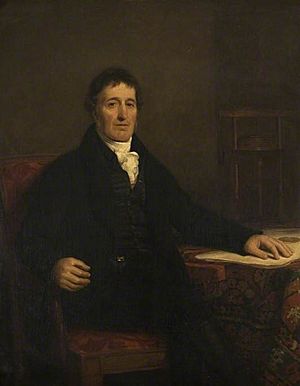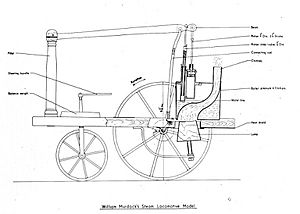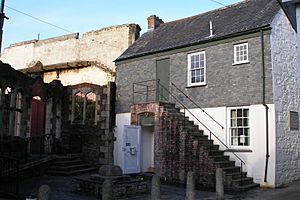William Murdoch facts for kids
Quick facts for kids
William Murdoch
|
|
|---|---|
 |
|
| Born | 21 August 1754 |
| Died | 15 November 1839 (aged 85) Handsworth, nr. Birmingham, England, United Kingdom
|
| Nationality | British |
| Citizenship | British |
| Awards | Rumford Medal (1808) |
| Scientific career | |
| Fields | Steam engines, Gas lighting |
William Murdoch (born August 21, 1754 – died November 15, 1839) was a clever Scottish inventor, chemist, and engineer. He made many important discoveries during the time of the Industrial Revolution.
Murdoch worked for a famous company called Boulton & Watt, which made steam engines. He spent ten years setting up these engines in Cornwall, England. Later, he lived most of his life in Birmingham, England.
Many people know Murdoch for inventing gas lighting in the early 1790s. He also created the word "gasometer" for gas storage. However, other inventors like Jean-Pierre Minckelers and Archibald Cochrane also worked on gas lighting around the same time.
Murdoch also improved steam engines, inventing things like the sun and planet gear and the D slide valve. He even created a steam gun and a pneumatic tube system for sending messages. He also helped build one of the first British paddle steamers to cross the English Channel. In 1784, Murdoch built a small prototype of a steam locomotive. He also made several important discoveries in chemistry.
William Murdoch worked for Boulton & Watt for a long time, even becoming a partner. But his amazing inventions are sometimes forgotten because his bosses, Matthew Boulton and James Watt, were so famous.
Contents
Early Life and Learning
William Murdoch was born in 1754 in a place called Bello Mill, near Old Cumnock in Ayrshire, Scotland. He was the third of seven children and the first son in his family to live past babyhood. His father, John Murdoch, was a millwright (someone who builds and repairs mills) and a former soldier.
William went to school until he was ten years old at the Old Cumnock Kirk School. After that, he attended Auchinleck school, where he became very good at arithmetic (math).
He also learned a lot about mechanics (how things work) by helping his father. He learned to experiment and work with metal and wood. Around 1763, he and his father built a "wooden horse," which was a tricycle powered by hand cranks. Some stories say he helped build bridges and experimented with coal gas by heating coal in a kettle. However, there are no old papers to prove these stories.
Starting Work in Birmingham
In 1777, when William was 23, he walked over 300 miles (480 km) to Birmingham. He wanted a job with James Watt, the famous steam engine maker. Watt's business partner, Matthew Boulton, was very impressed by a wooden hat Murdoch had made on a lathe (a machine for shaping wood or metal). So, Boulton hired him.
Murdoch started working in the Soho Foundry, making patterns for machine parts. By 1778, James Watt himself said that Murdoch was very good at understanding patterns and avoiding mistakes. When he moved to England, William changed the spelling of his name to "Murdock." He became very skilled at setting up and fixing steam engines and often traveled for this work.
In 1779, Boulton wrote that Murdoch was a "valuable man" who deserved encouragement. On his first job working alone, Murdoch improved the standard Boulton and Watt engine. He changed the gears so the steam valve would work automatically.
Working in Cornwall's Mines
In 1779, Murdoch was sent to Redruth in Cornwall. His job was to set up, maintain, and repair Boulton & Watt engines. These engines were very important for pumping water out of the Tin mines in Cornwall. The better the engines worked, the more tin (and money) could be taken from the mines.
Boulton & Watt didn't just sell engines. They also operated and maintained them, and their payment depended on how well the engines performed. Murdoch's skill in making the engines work efficiently directly helped Boulton and Watt earn more money. He was so good that in 1782, Boulton wrote that they needed "more Murdocks" because he was the most active and best engine erector he had ever seen.
Murdoch was always busy fixing and improving engines because problems often came up. He traveled a lot around the area to keep the mines running smoothly.
Dealing with Competition
In Cornwall, many different engine builders competed. They often copied each other's ideas and broke patents (legal rights to an invention). James Watt was very worried about his patents being copied. So, Murdoch had to report on competitors and give sworn statements for lawsuits. This was sometimes risky for him in the close-knit community of Cornwall.
Murdoch also had to inspect other companies' engines. He checked if they had copied Boulton & Watt's inventions or how well their engines worked.
Amazing Mechanical Inventions
While in Cornwall, Murdoch faced many mechanical problems with steam engines. This led him to make practical improvements to the designs used by Boulton and Watt. From 1782, he worked with Watt on new inventions. However, many of Murdoch's letters from this time are missing. Some people think Watt's son might have removed them to make his father seem like the only inventor.
It's likely that Murdoch's work contract said that anything he invented belonged to his employers. Often, Boulton and Watt would get the patents and benefit from his ideas.
One of Murdoch's most important inventions was the sun and planet gear. This gear allowed steam power to create a continuous spinning motion. It used a 'planet' (a cogwheel) that revolved around a 'sun' (another spinning cog) to turn a drive shaft. James Watt patented this system in his own name in 1781. But many, including Watt's biographer Samuel Smiles, believe Murdoch invented it. Matthew Boulton even wrote that he could have told Watt about it long ago when Murdoch first invented it.
In 1799, Murdoch invented a much simpler and more efficient steam wheel. This was an early version of the steam turbine. It allowed steam pressure to turn a wheel directly. By this time, Murdoch's contract had changed, and he could patent this device himself.
Murdoch also experimented with compressed air. He developed the first pneumatic message system. This system used compressed air to push a message in a cylinder through a tube. Companies like London Pneumatic Despatch Company used it widely, and Harrods department store used it until the 1960s. Murdoch even used compressed air to ring a doorbell at his home!
Some of his other smaller inventions included a machine for drilling wooden pipes (later stone pipes), a steam cannon (which he tried to use to knock down a wall), and a steam gun that fired lead bullets. He also created a material that looked like jet by pressing peat moss under high pressure.
Early Steam Locomotives
William Murdoch is not widely known for it, but he built Britain's first working model of a steam carriage (a vehicle that moves on roads using steam power) in 1784. A French engineer, Nicolas-Joseph Cugnot, had already built full-sized steam vehicles, but Murdoch's design was more effective.
In March 1784, Murdoch's colleague, Thomas Wilson, wrote to James Watt about Murdoch's "new scheme" to use steam engines to pull carriages on roads. Watt didn't think this idea had a future and tried to stop Murdoch from working on it. Watt was afraid of losing Murdoch's valuable work in Cornwall.
Matthew Boulton later shared more details about Murdoch's ideas. He said Murdoch wanted to collect condensed steam and use different-sized wheels for hills and valleys. Boulton also secretly told Watt to include a steam-powered carriage idea in his own patent application, which Watt did.
Murdoch had already built a working model of his steam carriage. People saw it run around his living room in Redruth in 1784. This was the first time a machine in Great Britain moved completely on its own power.
Murdoch's model was a three-wheeled vehicle about a foot tall. It had the engine and boiler between the two back wheels, a spirit lamp to heat the water, and a handle at the front to steer. The model included new ideas like a boiler safety valve and a new valve system.
Murdoch continued to experiment and built at least one more model by 1786. He tried to patent his steam locomotive, but Matthew Boulton convinced him to go back to Cornwall without registering the patent. Boulton wrote that Murdoch was eager to make steam carriages but was persuaded to return.
Murdoch later demonstrated his steam carriage at the King's Head hotel in Truro. This was the first public demonstration of steam locomotion in Britain.
Even though Boulton and Watt didn't support his work, Murdoch likely continued to work on his steam carriages. Some people even believe he built a full-sized version. There's a famous story about Murdoch testing his carriage at night. It went so fast that he had to chase it! He supposedly met a clergyman who thought the smoking, fiery carriage was the devil. This story is probably about a model, not a full-sized carriage.
In 1797 and 1798, Richard Trevithick, another famous inventor, lived next door to Murdoch in Redruth. Trevithick would have seen Murdoch's experiments and been influenced by them. Murdoch's son, John, also told a story about Trevithick seeing a model engine in 1794 that worked with strong steam and no vacuum.
Without the support of Boulton and Watt, who didn't trust high-pressure steam, Murdoch couldn't develop his invention further. So, it was left to Trevithick and others to make steam locomotives popular later on.
Discoveries in Chemistry
Besides his mechanical work, William Murdoch also experimented with chemistry and made several discoveries.
One discovery, first noted in 1784, was iron cement. He found it when sal ammoniac (a chemical) and iron filings accidentally mixed in his tool bag and formed a solid mass. This iron cement was used to make steam engine joints strong and leak-proof.
Murdoch also got his first patent for a way to make new kinds of copperas, vitriol, and different dyes, paints, and colors. He also created a special mix to protect wooden ships and other wood in water from worms and barnacles. This patent was filed in 1791. Even though it wasn't fully developed then, it was an early step towards modern aniline dyes and coatings.
British Isinglass
In 1795, Murdoch created a replacement for isinglass. Isinglass was a substance made from sturgeon fish, imported from Russia, and used to make beer clear. It was very expensive. Murdoch's replacement was made from dried Cod fish and was much cheaper.
The Committee of London Brewers paid £2000 to use his invention because it saved them so much money. Murdoch's "Isinglass made of British fish" was so good that a famous chemist, Sir Humphry Davy, said it was the same as regular isinglass and worked well for clearing beer. This invention helped British brewers rely less on imported materials.
The Invention of Gas Lighting
William Murdoch is most famous for using gas lighting to replace oil and tallow lamps. He started experimenting with gas from heated coal in 1792. Many believe he did these experiments in a cave. It's not clear exactly when he first showed it working, but most sources say it was between 1792 and 1794.
To use gas for lighting, he needed a way to produce and collect it. By 1794, Murdoch was making coal gas from a small oven with heated coals. He piped the gas through an iron tube and an old gun barrel, then lit it to make light.
Murdoch's house in Redruth was the first home to be lit by gas.
Over the next few years, he did many experiments to find out how much gas different substances produced. He also found the best ways to transport, store, clean, and light the gas. William Fairbairn, a friend, said that Murdoch sometimes used his gas as a portable lantern on dark winter nights. He would fill a bladder with gas and use it like a bagpipe to light their way home.
In 1798, Murdoch moved back to Birmingham and continued his gas experiments. He lit parts of the main building at the Soho foundry. In 1802, he publicly showed his lighting by illuminating the outside of the Soho Foundry to celebrate the Peace of Amiens.
The first factory to be fully lit by gas was the Philips and Lee cotton mill in Manchester in 1805. Murdoch lit this mill, which started with 50 gas lights and soon had 904. It took time to complete because Murdoch kept improving the process. For example, he learned to clean the gas with lime to remove the smell and found the best temperature to heat coal for the most gas.
Murdoch never made money from his gas lighting invention because he didn't get a patent. This might have been because James Watt Junior said it wasn't patentable. This left the gas industry open for others to use, like his former assistant Samuel Clegg. Boulton and Watt didn't expand into street and home lighting, even though they were very successful in factory lighting. They even blocked a competitor, the National Heat and Light Company, from getting a charter until 1812. But they didn't develop the gas market themselves and left the gas business in 1814. A few decades later, most towns in Britain were lit by gas.
Besides light and heat, making coal gas also produced other useful substances. These included coke (a fuel), ammonia, phenol (a disinfectant), and coal tar. Coal tar contained many organic chemicals and was later used to make the first synthetic dye, mauve, and even aspirin.
The Caledonia Paddle Steamer
Boulton and Watt had some involvement in steam-powered boats. In 1807, they provided the engine for Robert Fulton's North River Steamboat, the first steamboat on the Hudson River. Murdoch was mainly in charge of designing and building this engine and working with Fulton on the details.
However, Boulton and Watt didn't get seriously involved in marine engineering until 1817, when James Watt Jr. bought a ship called The Caledonia. Murdoch, even though he was often sick, led the difficult task of refitting The Caledonia, building new engines and boilers, and making her efficient.
By August, the ship was ready for testing. It could travel 8 miles per hour (mph). During trials, Murdoch experimented with the ship's paddles and engines, increasing its speed to 12 mph (19 km/h).
The Caledonia raced against a competitor, the Sons of Commerce, and won both times. Because of this, the owners of the Sons of Commerce ordered a new steamboat engine from Boulton and Watt. Many other orders for steamboat engines followed, including from the Royal Navy. Murdoch was the leader of this part of the business. From 1813 to 1825, Boulton and Watt made marine engines for about 40 to 60 ships.
After the trials, The Caledonia crossed the English Channel when Watt Jr. took it to Rotterdam and up the Rhine River.
Later Years and Legacy
In 1808, Murdoch wrote a paper called "Account of the Application of Gas from Coal to Economical Purposes," which he presented to the Royal Society. That same year, he received the Rumford Gold Medal for being the first to think of and actually use gas for practical purposes.
In 1817, Murdoch moved into a large new house he had built outside Birmingham. His house had many cool inventions he designed, like gas lighting, a doorbell that worked with compressed air, and an air conditioning system. In 1815, he also designed and installed the first modern gravity-fed, piped hot water system at the Royal Pump Rooms in Leamington Spa.
In September 1830, at age 76, Murdoch's partnership with Boulton & Watt ended. He was getting £1,000 a year at that time. This happened because Boulton and Watt were becoming less profitable, and Murdoch's health was getting worse.
William Murdoch died in 1839, at 85 years old. He was buried at St. Mary's Church, Handsworth.
Honors and Awards
In 1892, to celebrate 100 years of gas lighting, a statue of Murdoch was revealed by Lord Kelvin in the Wallace Monument in Stirling. There is also a statue of him by Sir Francis Legatt Chantrey at St. Mary's Church.
His life and work are remembered by the Lunar Society Moonstones and a statue of him, Boulton, and Watt by William Bloye, all in Birmingham. There is also a Murdoch House in Rotherhithe, London.
The town of Redruth holds an Annual Murdoch Day in June. In 2007, they had a parade and the first public journey of a full-sized, working copy of Murdoch's Steam Carriage.
In 2019, William Murdoch was added to the Scottish Engineering Hall of Fame.
Images for kids
See also
 In Spanish: William Murdoch para niños
In Spanish: William Murdoch para niños












